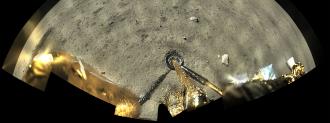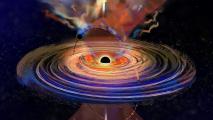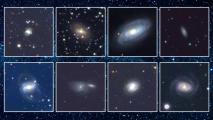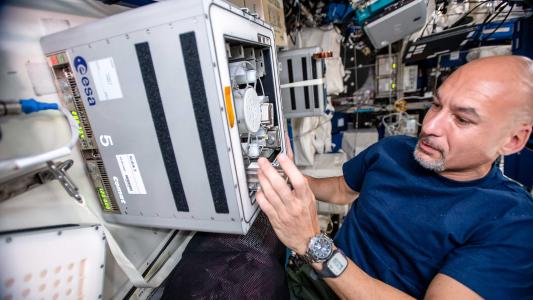China’s Chang’e 5 probe has gathered its first sampling of moon rocks, according to the state-run Xinhua News Agency, the AP reports.
With the simple declaration “Chang’e has collected moon samples,” the China National Space Administration announced history, as China will be only the third nation in the world — behind the great space powers of the U.S. and the former Soviet Union — to bring moon rocks and other geographic samples home to earth.
Those aren’t the only extraterrestrial rocks we’re getting, either; scientists will also soon be getting pieces of debris from the asteroid Ryugu. JAXA — the fittingly futuristically named Japanese space agency — will return asteroid dust and grains collected by their probe Hyabusa2 on December 5.
And that’s not all, folks, because if you order before, oh, September 24, 2023, then you could have samples from yet another asteroid, Bennu, plucked from the heavens by NASA’s OSIRIS-REx mission.
All of which raises the question: why do we want a rock anyway?
Why You Should Care About Space Rocks
Beside the fact that you’re holding something in your hand that is literally from out of this world (and potentially billions of years old), moon rocks and other geological debris contain insights into the origins of the solar system and the various bodies within it.
“The rocks contain interesting, often exciting, stories. They reveal their stories through the scientist’s experienced eyes and sophisticated instruments,” reads NASA’s laconically titled “What We’ve Learned About The Moon.”
Moon rocks’ shape, size, and composition, down to the very crystal and grain, hold important clues to the satellite’s formation — and the environment in which it was formed. On Earth, we have a whole host of factors that continually re-wipe our geological record; rain, wind, plate tectonics, supervolcanoes.
Not so on the moon; moon rocks and other forms of heavenly debris can remain on their surfaces, ready to reveal to us just what they’ve been dealing with. And since Apollo’s moon rocks ranged from about 3.2 to 4.6 billion years old, per Space, they’ve seen a lot.
“The (lunar) crust is basically an archive,” Rutgers planetary scientist Juliane Gross told Vox‘s Brian Resnick. “And we need to learn how to interpret and how to read that archive.”
Space Scars
According to NASA, radioactive clocks can tell us the age of the rocks. Perhaps more importantly, they have helped us determine the age of the moon’s craters. This is important because, much like scars, craters can tell us quite a bit about the past, and knowing the age of moon craters means we can also date other planets’ and moons’ craters, just by lookin’ at them.
As Resnick explains, bigger craters tend to be older craters, as there was more large junk flying around the universe in the beginning. And with baseline dates from the moon’s rocks, “we have a beautiful impact history of the solar system,” Darby Dyar, of the Planetary Science Institute, told Resnick.
Utilizing the craters dated via moon rocks, scientists can put together a long, long, long history of violence, discovering when the solar system was getting pummeled — and perhaps why.
One pretty wild possibility, per Vox, is that our big, beautiful outer planets — Jupiter, Saturn, Uranus, and Neptune — had shifted their orbits about 600 million years after the planets formed, a waggling that may have disturbed, and sent screaming across the solar system, the asteroids.
Lunar Genesis
At some point during all that planetary formation, our big shiny moon was formed as well. But whether it was made from us, by a collision with us, or was merely snagged by us hasn’t been entirely settled, the leading theories waxing and waning.
One of the most prominent hypotheses has moon rocks at its core.
In this theory, a proto-Earth, minding its own business in the glow of a relatively new sun, got walloped by a planetoid roughly the size of Mars. This cataclysmic collision, in addition to being something I’d desperately want to see from a safe distance, may have flung material from both planets, which then glommed together and formed the Earth and Moon. (I call this the T-1000 method; real scientists prefer “giant impact hypothesis.”)
As Dyar told Vox, moon rocks made of cooled molten lava — called plagioclase — are what you’d expect to find forming the crust of a super-hot baby satellite. And since the Earth and moon are composed of similar materials, and the presence of plagioclase means things were molten, it seems plausible.
Moon rocks have also called into question a very similar theory, that Earth was struck by an object called Theia, the resulting rubble of which made the moon. But according to the New York Times, geochemists have studied various metals in the Apollo moon rocks, and found that they cannot be told apart from those on Earth. Theia should be chemically distinct compared to Earth; if the moon was made from Theia, it should look like that planet, not us.
Ready to Rock (Sorry)
The moon rocks Chang’e 5 is scheduled to bring back in mid-December may help bolster our fundamental knowledge of not just the moon, but our future around — and even upon — it. Their tracks and weatherings hold clues about solar radiation; their structures could lead to mining techniques for minerals and other natural resources found in them (for example, helium, increasingly scarce on Earth).
What we’ve garnered now has come from an impossibly small sample size; the 840 pounds of moon rocks, dust, and other Apollo samples sounds like a lot, but is nothing compared to the surface of the moon itself. There are vast regions unsampled, which risks skewing our results with sample bias. And there is a whole side of the moon none of us have ever touched.
Resnick asked planetary scientist Juliane Gross if scientists would find it valuable to have moon rocks from other spots on the moon, of the kind Chang’e 5 is delivering to Inner Mongolia from the Ocean of Storms as an early Christmas gift.
“Oh, hell yeah,” Gross replied. “Absolutely.”






